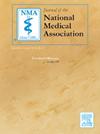Relationship between race, income-level, and Cardiovascular Disease
IF 2.5
4区 医学
Q1 MEDICINE, GENERAL & INTERNAL
引用次数: 0
Abstract
Aim
To study the prevalence of cardiovascular disease (CVD) and associated risk factors among different races/ethnicities across different income groups.
Methods
This retrospective analysis included data from the National Health and Nutrition Examination Survey from 2005-2018. Adults >20 years who identified as non-Hispanic (NH) White, NH Black, or Hispanic were included. Family income-to-poverty ratio (PIR) was calculated by dividing family income by poverty guidelines specific to the survey year and divided into four quartiles. Weighted logistic regression was performed to estimate adjusted odds ratios to determine association of race/ethnicity and CVD in each PIR quartile. Models were adjusted for age, sex, race, health insurance, marital status, citizenship status, education level, and PIR.
Results
We included 31,884 adults that corresponded to ∼191.3 million weighted, nationally representative participants. Of these, 8,009, 7,967, 7,944, and 7,964 participants belonged to 1st, 2nd, 3rd, and 4th quartiles, respectively. The prevalence of diabetes mellitus (DM), hypertension, coronary artery disease (CAD), congestive heart failure (CHF), and stroke decreased with each successive PIR quartile. NH Black participants had higher prevalence odds of DM, hypertension, obesity, CHF, and stroke compared to NH White participants. The difference in prevalence odds between NH White adults and NH Black adults was greater for obesity (p-interaction=0.002), DM (p-interaction=0.027), and stroke (p-interaction=0.053) in the 4th PIR quartile (highest income) compared to the 1st PIR quartile (lowest income).
Conclusion
Racial and ethnic disparities in the risk of CVD persists across income levels, with a greater difference in prevalence of select CVD and risk factors between NH Black and NH White participants in the highest income quartile compared to the lowest income quartile.
种族、收入水平与心血管疾病之间的关系
研究不同收入群体中不同种族/族裔的心血管疾病(CVD)患病率及相关风险因素。这项回顾性分析包括 2005-2018 年国家健康与营养调查的数据。研究对象包括年龄大于 20 岁的非西班牙裔(NH)白人、NH 黑人或西班牙裔成年人。家庭收入与贫困比率(PIR)的计算方法是将家庭收入除以调查年份的贫困准则,并分为四个四分位数。采用加权逻辑回归法估算调整后的几率比,以确定每个 PIR 四分位数中种族/人种与心血管疾病的关系。模型根据年龄、性别、种族、医疗保险、婚姻状况、公民身份、教育水平和 PIR 进行了调整。我们纳入了 31,884 名成年人,相当于 1.913 亿名具有全国代表性的加权参与者。其中,8009 人、7967 人、7944 人和 7964 人分别属于 1、2、3 和 4 四分位数。糖尿病 (DM)、高血压、冠状动脉疾病 (CAD)、充血性心力衰竭 (CHF) 和中风的患病率随着 PIR 四分位数的增加而降低。与新罕布什尔州的白人参与者相比,新罕布什尔州的黑人参与者患糖尿病、高血压、肥胖症、冠心病和中风的几率更高。在肥胖症(p-交互作用=0.002)、糖尿病(p-交互作用=0.027)和中风(p-交互作用=0.053)方面,与 PIR 四分位数 1(收入最低)相比,PIR 四分位数 4(收入最高)的新罕布什尔州白人成人和新罕布什尔州黑人成人之间的患病几率差异更大。在不同收入水平的人群中,心血管疾病风险的种族和民族差异依然存在,与最低收入四分位数相比,最高收入四分位数的北卡罗来纳州黑人和北卡罗来纳州白人参与者在某些心血管疾病和风险因素的患病率上差异更大。
本文章由计算机程序翻译,如有差异,请以英文原文为准。
求助全文
约1分钟内获得全文
求助全文
来源期刊
CiteScore
4.80
自引率
3.00%
发文量
139
审稿时长
98 days
期刊介绍:
Journal of the National Medical Association, the official journal of the National Medical Association, is a peer-reviewed publication whose purpose is to address medical care disparities of persons of African descent.
The Journal of the National Medical Association is focused on specialized clinical research activities related to the health problems of African Americans and other minority groups. Special emphasis is placed on the application of medical science to improve the healthcare of underserved populations both in the United States and abroad. The Journal has the following objectives: (1) to expand the base of original peer-reviewed literature and the quality of that research on the topic of minority health; (2) to provide greater dissemination of this research; (3) to offer appropriate and timely recognition of the significant contributions of physicians who serve these populations; and (4) to promote engagement by member and non-member physicians in the overall goals and objectives of the National Medical Association.

 求助内容:
求助内容: 应助结果提醒方式:
应助结果提醒方式:


